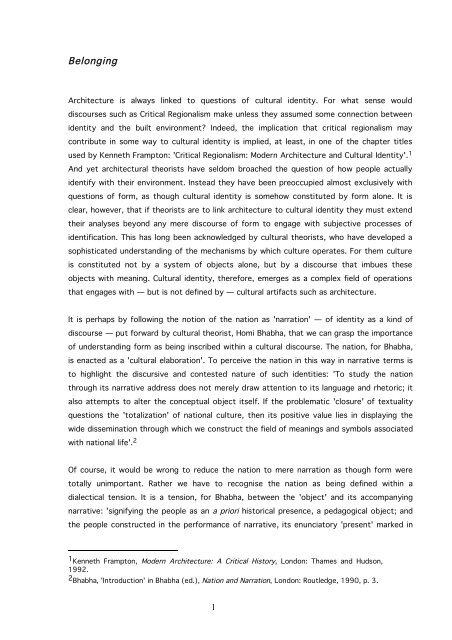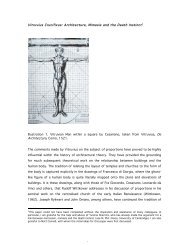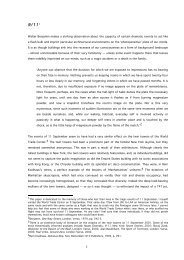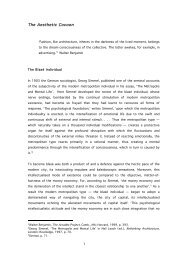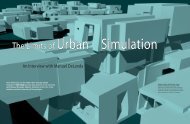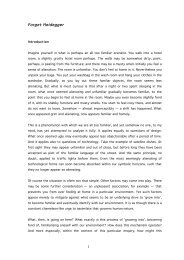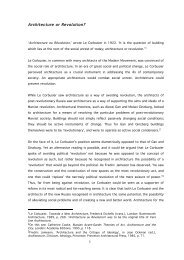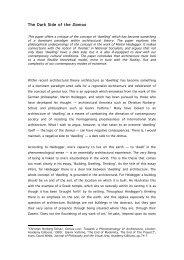1 Belonging - Neil Leach
1 Belonging - Neil Leach
1 Belonging - Neil Leach
You also want an ePaper? Increase the reach of your titles
YUMPU automatically turns print PDFs into web optimized ePapers that Google loves.
<strong>Belonging</strong>Architecture is always linked to questions of cultural identity. For what sense woulddiscourses such as Critical Regionalism make unless they assumed some connection betweenidentity and the built environment? Indeed, the implication that critical regionalism maycontribute in some way to cultural identity is implied, at least, in one of the chapter titlesused by Kenneth Frampton: 'Critical Regionalism: Modern Architecture and Cultural Identity'. 1And yet architectural theorists have seldom broached the question of how people actuallyidentify with their environment. Instead they have been preoccupied almost exclusively withquestions of form, as though cultural identity is somehow constituted by form alone. It isclear, however, that if theorists are to link architecture to cultural identity they must extendtheir analyses beyond any mere discourse of form to engage with subjective processes ofidentification. This has long been acknowledged by cultural theorists, who have developed asophisticated understanding of the mechanisms by which culture operates. For them cultureis constituted not by a system of objects alone, but by a discourse that imbues theseobjects with meaning. Cultural identity, therefore, emerges as a complex field of operationsthat engages with — but is not defined by — cultural artifacts such as architecture.It is perhaps by following the notion of the nation as 'narration' — of identity as a kind ofdiscourse — put forward by cultural theorist, Homi Bhabha, that we can grasp the importanceof understanding form as being inscribed within a cultural discourse. The nation, for Bhabha,is enacted as a 'cultural elaboration'. To perceive the nation in this way in narrative terms isto highlight the discursive and contested nature of such identities: 'To study the nationthrough its narrative address does not merely draw attention to its language and rhetoric; italso attempts to alter the conceptual object itself. If the problematic 'closure' of textualityquestions the 'totalization' of national culture, then its positive value lies in displaying thewide dissemination through which we construct the field of meanings and symbols associatedwith national life'. 2Of course, it would be wrong to reduce the nation to mere narration as though form weretotally unimportant. Rather we have to recognise the nation as being defined within adialectical tension. It is a tension, for Bhabha, between the 'object' and its accompanyingnarrative: 'signifying the people as an a priori historical presence, a pedagogical object; andthe people constructed in the performance of narrative, its enunciatory 'present' marked in1 Kenneth Frampton, Modern Architecture: A Critical History, London: Thames and Hudson,1992.2 Bhabha, 'Introduction' in Bhabha (ed.), Nation and Narration, London: Routledge, 1990, p. 3.1
the repetition and pulsation of the national sign'. 3 If then the nation is a kind of narration, itis never an abstract narration, but a contextualised narration in which certain objects areinscribed. And it is precisely here within this field of objects which have themselves becomethe focus of narrative attention that we must locate architecture, as a language of forms notonly embedded within various cultural discourses, but also given meaning by thosediscourses.This brings us close to Pierre Bourdieu's concept of habitus, as a non-conscious system ofdispositions which derive from the subject's economic, cultural and symbolic capital. Habitus,for Bourdieu is a dynamic field of behaviour, of position-taking where individuals inherit theparameters of a given situation, and modify them into a new situation. As Derek Robbinsexplains: 'The habitus of every individual inscribes the inherited parameters of modification,of adjustment from situation to position which provides the legacy of a new situation.' 4 Suchan approach supposes an interaction between social behaviour and a given objectifiedcondition. It is here that we could perhaps locate the position of architecture in Bourdieu'sdiscourse.Architecture, in Bourdieu's terms, can be understood as a type of 'objectivated culturalcapital'. Its value lies dormant and in permanent potential, but it has to be reactivated bysocial practices which will, as it were, 'revive' it. In this respect, architecture belongs to thesame category as other cultural objects: 'Although objects — such as books or pictures —can be said to be the repositories of objectivated cultural capital, they have no value unlessthey are activated strategically in the present by those seeking to modify their incorporatedcultural capital. All those objects on which cultural value has ever been bestowed lieperpetually dormant waiting to be revived, waiting for their old value to be used to establishnew value in a new market situation.' 5 In other words, what Bourdieu highlights is the needfor praxis to 'unlock' the meaning of an object. In a sense this comes close to theWittgenstinian model of language wherein meaning is defined by use. Just as words can beunderstood by the manner in which they are used, so buildings can be grasped by the mannerin which they are perceived — by the narratives of use in which they are inscribed.This opens up a crucial problematic within an architectural discourse that has traditionallybeen premised almost solely on questions of form. It is as though narratives of treatmentand use stand largely outside architectural concerns. Thus Critical Regionalism, for example,in investing form with such significance, does not recognise how the same form will take on3 Bhabha, 'DissemiNation' in Bhabha (ed.), Nation and Narration, London: Routledge, 1990, pp. 298-299.4 Derek Robbins, Bourdieu and Culture, London: Sage, 2000, p. 30.5 Derek Robbins, Bourdieu and Culture, London: Sage, 2000, p. 35.2
adically different connotations in different cultural milieus. The same concrete tower block— replicated in, say, New York, Hong Kong, Latin America and Eastern Europe — willeffectively appear different as it is treated and used differently in each context. Furthermore,in standard architectural theory there is no accepted framework for exploring how peoplemake sense of place and identify with it. Without this, the relation of architecture to culturalidentity can hardly be addressed. In order for architecture to be understood in terms ofcultural identity, some kind of identification with architecture must have taken place. Buthow exactly does this identification occur?This article attempts to offer one model that might help to explain this process, and thatmight therefore address one of the crucial problems that exists within theories such asCritical Regionalism that restrict themselves to a discourse of form. It argues that a highlysuggestive model for understanding the relationship between physical form and culturalidentity — ‘belonging’ — can be drawn from Judith Butler’s work on ‘performativity’.Butler and PerformativityJudith Butler has elaborated a vision of identity which is based on the notion of'performativity'. It is an approach that allows her to perceive identity in a far more fluid anddynamic way than traditional approaches to the question. It is an approach, moreover, thatrecognises identity politics as a field of individual empowerment.Butler is a theorist of gender politics — and more specifically lesbian politics. Her concern isto formulate a notion of identity that is not constrained by traditional heterosexual modelsand to offer a radical critique of essentialising modes of thinking. According to Butler, it isprecisely our actions and behaviour that constitute our identity, and not out biologicalbodies. Gender, she argues, is not a given ontological condition, but it is performativelyproduced. It is 'a construction that conceals its genesis,' such that, 'the tacit collectiveagreement to perform, produce and sustain discrete and polar genders as cultural fictions isobscured by the credibility of those productions.' 6We may effectively rearticulate our identities and reinvent ourselves through ourperformativities. Here it is important to note that identity is the effect of performance, andnot vice versa. Performativity achieves its aims not through a singular performance — forperformativity can never be reduced to performance — but through the accumulative6 Judith Butler, Gender Trouble, London: Routledge, 1990, p. 140, as quoted in Vikki Bell (ed.),Performativity and <strong>Belonging</strong>, London: Sage, 1999, p. 136.3
iteration of certain practices. It is grounded in a form of citationality — of invocation andreplication. As Judith Butler explains: 'Performativity is thus not a singular 'act', for it isalways a reiteration of a norm or set of norms, and to the extent that it acquires an act-likestatus in the present, it conceals and dissimulates the conventions of which it is arepetition.' 7Butler figures identity not as something interior — an essentialising 'given' — but rather assomething exterior, a discursive external effect. It is borne of 'acts, gestures andenactments' that are 'performative,' as Butler puts it, 'in the sense that the essence oridentity that they otherwise purport to express are fabrications manufactured and sustainedthrough corporeal signs and other discursive means. That the gendered body is performativesuggests that it has no ontological status apart from the various acts which constitute itsreality. This also suggests that if that reality is fabricated as an interior essence, that veryinteriority is an effect and function of a decidedly public and social discourse, the publicregulation of fantasy through the surface politics of the body, the gender border control thatdifferentiates inner from outer and institutes the 'integrity' of the subject.' 8 Importantly, thisrelates not just to lesbian sexuality, but to all sexualities, such that heterosexuality itselfemerges as a socially transmitted construct that depends upon a behavioural norm being'acted out'.Here the connections between gender and 'mime' begin to emerge. Indeed Butler's wholediscourse, it would appear, depends upon mime in general and the mimetic in particular. Allbehaviour is based on a kind of mimicry, including normative heterosexual behaviour that isthereby 'naturalised' and instantiated by the force of repetition: 'All gendering is a kind ofimpersonation and approximation. . . the naturalistic effects of heterosexualised genders areproduced through imitative strategies; what they imitate is a phantasmatic ideal ofheterosexual identity, one that is produced by imitation as its effect.' 97 Butler, Bodies that Matter, London: Routledge, 1993, p. 12.8 Butler, Gender Trouble, London: Routledge, 1990, p. 136, as quoted in Vikki Bell (ed.), Performativityand <strong>Belonging</strong>, London: Sage, 1999, p. 136.9 Butler, 'Imitation and Gender Insubordination', in D Fuss (ed.), Inside/Out: Lesbian and Gay Theories,New York: Routledge, 1991, as quoted in Bell, p. 137. There are parallels here with Irigaray's use ofmimesis in the constitution of gender: 'to play with mimesis is thus, for a woman, to try to recover theplace of her exploitation by discourse, without allowing herself to be simply reduced to it. It means toresubmit herself — in as much as she is on the side of the 'perceptible', of 'matter' — to 'ideas', inparticular to ideas about herself, that are elaborated in/by a masculine logic, but so as to make 'visible'by an effect of playful repetition, what was supposed to remain invisible: the cover up of a possibleoperation of the feminine in language.' [Luce Irigaray, This Sex Which is not One, trans. C Porter and CBurke, Ithaca, NY: Cornell University Press, 1985, p. 76.] There is an important distinction, however,between Butler's and Irigaray's use of the term. For Irigaray mimesis is at work in feminine language andoffers a means of resisting a dominant, masculine logic, while for Butler mimesis explains the manner inwhich gender of whatever kind is constituted. As Bell notes: 'For Irigaray, mimesis is on the level ofstrategy — one that reveals through its repetition of ideas about women — and not of constitution, asit is for Butler.' [Bell, p. 139.]4
Cultural practices are governed by the hegemonic. They instantiate a certain order, andencourage acquiescence to that order. They are propagated through a desire to conform.This is particularly evident in the case of gender practices. 10 Normative gender practice iscontrolled by the logic of camouflage. To subscribe to the dominant cultural norm is to avoidconflict and to follow the behavioural systems of a naturalised, hegemonic order. And it is asa camouflage that gender can be understood as an 'effective' cultural praxis.Gender, in this sense, approaches a notion of drag. It is a position that is 'assumed', andplayed out within the logic of conformity to some accepted norm. In making this claim, Butlerdestablises the traditional authority of heterosexuality: 'To claim that all gender is like drag,or is drag, is to suggest that 'imitation' is at the heart of the heterosexual project and itsgender binarisms, that drag is not a secondary imitation that presupposes a prior and originalgender, but that hegemonic heterosexuality is itself a constant and repeated effort toimitate its own idealisations.' 11Butler is concerned to challenge the hegemony of the given. Nothing is authentic in itself.Everything is authorised through repetition. Yet through its own repetition it begins toinstantiate a certain norm. It is important to recognise, however, that any norm can bedestabilised. And it is precisely the normative nature of received views on gender that Butlerseeks to undermine. For Butler, gender should be seen not as a given state, but as acondition of 'becoming'. Echoing Deleuze she sees it as a rhizomatic condition, that is anactative process: 'If gender is something that one becomes — but can never be — thengender is itself a kind of becoming or activity, and that gender ought not to be conceived asa noun or a substantial thing or a static cultural marker, but rather as an incessant andrepeated action of some sort.' 12Butler's discourse is effectively an extension to Pierre Bourdieu's debate about habitus as adynamic field of behaviour, of position-taking where individuals inherit the parameters of a10 This leads to a certain pessimism in Butler's work. As Vikki Bell argues: 'The category of mimicry asButler employs it in her work is one that I would argue carries with it a sense of sadness, both offorfeiting (possibilities of being otherwise) and of resignation to 'carrying on' under duress. There is noplayful repetition here. Gender performance is regarded as a strategy of survival, formed within aheterosexual matrix which, while not compulsory, is hegemonic, such that the psychic structures itdeploys are analogous to melancholia, in which the lost object is incorporated into psychic life as partof the ego, object of ambivalence, ie both loved and hated.' [Vikki Bell (ed.), Performativity and<strong>Belonging</strong>, London: Sage, 1999, p. 140.]11 Butler, Bodies that Matter, p. 125.12 Butler, Gender Trouble, p. 112.5
given situation, and modify them into a new situation. 13 But what Butler brings to thatdebate is the possibility of political agency, and of subverting received norms. It is throughits repetitive citational nature that performativity has the power to question and subvertthat which it cites. Whereas Bourdieu stresses the production of the subject through culture,for Butler, social structures have themselves been 'performed'. Hence performativity offersan obvious mode of challenging such structures. Imitation lies at the heart of all culturalpractices. It is that which reinforces them, but — equally — that which potentiallydestablises them.This is a radical re-evaluation of the mechanics of cultural practice, that has ramifications forevery aspect of cultural life. Without collapsing sexuality, class, race and ethnicity into thesame category, all types of identity can also be interpreted as dependent upon performativeconstructs. 14 While each operates within its own individual paradigms, the general frameworkremains similar. Each depends upon the performative, each is citational in character, and eachis 'effective'. This is not to overlook the significance of physical characteristics, but rather tochallenge the notion that these characteristics are the sole determinants of identity.According to such a view, the constitution of one's identity through performativity extendsbeyond questions of appearance into modalities of behaviour and modes of perception andexpression. In the context of race, for example, we have to acknowledge how the process of'racing' something or 'being raced' might operate. For performativity also operates in modesof perception, such as the 'gaze' which, as it were, 'colour' and frame our view of the world,but — importantly — also constitute it. To be 'black' is to view the world with a 'black'gaze. 15 What applies to the gaze also applies to other modes of perception or expression.Butler importantly locates performativity at the heart of our cultural identity today. In an ageincreasingly colonised by 'fictional worlds', as Marc Augé has observed, where fantasy allows13 As Derek Robbins explains: 'The habitus of every individual inscribes the inherited parameters ofmodification, of adjustment from situation to position which provides the legacy of a new situation.'Derek Robbins, Bourdieu and Culture, London: Sage, 2000, p. 30.14 Bell discusses the possibility of understanding Jewishness in this light in Vikki Bell (ed.),Performativity and <strong>Belonging</strong>, London: Sage, 1999. See also Sneja Gunew, ‘Performing AustralianEthnicity: “Helen Demidenko”, in W. Ommundsen and H. Rowley (eds.) From a Distance: AustralianWriters and Cultural Displacement, Geelong: Deakin University Press, 1996, pp. 159-171.15 Butler herself has addressed this question: 'I do think that there is a performativity to the gaze thatis not simply the transposition of a textual model onto a visual one; that when we see Rodney King,when we see that video we are also reading and we are also constituting, and that the reading is acertain conjuring and a certain construction. How do we describe that? It seems to me that that is amodality of performativity, that it is radicalization, that the kind of visual reading practice that goesinto the viewing of the video is part of what I would understand as the performativity of what it is 'torace something' or to be 'raced' by it. So I suppose that I'm interested in the modalities ofperformativity that take it out of its purely textualist context.' [Judith Butler (interviewed by VikkiBell), 'On Speech, Race and Melancholia', in Vikki Bell (ed.), Performativity and <strong>Belonging</strong>, London: Sage,1999, p. 169.]6
identities to be assumed and discarded like fashion accessories, and where self-realisationoften conforms to models drawn from Hollywood, the concept offers a more productivealternative to traditional understandings of the constitution of the self. 16 The whole notionof identity as some fixed and stable condition deserves to be re-interrogated in an age oftheming, role-playing and identity politics, where identities must be perceived in the plural, asmultiple and often seemingly contradictory modes of personal expression. Nor is thisnecessarily negative. Indeed such tactics can be analysed as a defensive mechanism thatallows the individual to 'survive' within contemporary cultural conditions. Indeed, as SherryTurkle has argued within the context of a proliferation of 'screen identities' as a result of theincreasingly widespread use of the computer, multiple personality disorder can be seen lessas a problematic symptom of an age of instability and depthlessness, and more as a strategyof survival — a kind of cultural camouflage — that enables individuals to operateproductively in a variegated and multi-faceted world. 17Politics and SpaceThe emphasis which Butler places on performativity does not undermine the underlying valueof form. Indeed this is the main message in Butler's seminal work, Bodies that Matter. 18 Hersis an essentially corporeal philosophy of identity. Butler's discourse also serves, however, asa corrective to a certain positivistic theory of form that is still pervasive. Matter — in Butler'sterms — does not exist outside of discourse. As Mariam Fraser observes, following Butler:'Matter does not 'exist' in and of itself, outside or beyond discourse, but is rather repeatedlyproduced through performativity, which "brings into being or enacts that which it names".' 19This has obvious ramifications for any discourse of gender and space. Butler's incisivecomments on gender — gender identity being defined not in biological terms, but inperformative terms as an identity that is 'acted out' — can be profitably transposed to therealm of physical space. For if identity is performed, then the space in which thatperformativity takes place can be seen as a stage. After a certain number of performancesthat stage will no longer seem neutral. It will be imbued with associations of the activitiesthat took place there, on the part of those who witnessed those activities. If identity is aperformative construct — if it is acted out like some kind of 'filmscript' — then architecturecould be understood as a kind of 'filmset'. But it is as a 'filmset' that it derives its meaning16 Marc Augé, A War of Dreams, trans. Liz Heron, London: Pluto, 1999.17 Sherry Turkle, Life on the Screen, New York: Simon and Schuster, 1995.18 Butler, Bodies that Matter, London: Routledge, 199319 Mariam Fraser, 'Classing Queer' in Vikki Bell (ed.), Performativity and <strong>Belonging</strong>, London: Sage, 1999,p. 111.7
from the activities that have taken place there. Memories of associated activities hauntphysical space like a ghost.It is here that Butler's thinking can be deployed as a way of cutting through much confusionthat exists on the question of the gendering of space. Too often there has been a simplisticcollapsing of a particular political ideology on to a particular form, as though a politicalideology can be conflated with an aesthetic ideology. This refers as much to politics ingeneral as it does to the specific question of gender politics. According to this logic, certainforms are in and of themselves imbued with a certain content. Just as there are seen to becertain 'democratic' forms, so there are certain 'feminine' forms. It is this thinking thatFredric Jameson has sought to challenge. Form, for Jameson, is essentially 'inert' andwhatever content is grafted on to it is 'allegorical' in character. 20 There is no intrinsicmeaning or political potential to any form. Whilst there may indeed be certain forms that'lend' themselves to democratic purposes rather than totalitarian ones, and — equally — nodoubt certain forms that 'embody' a feminine sensibility, it is surely a mistake to map certainactivities on to certain forms, as though those activities were a consequence of those forms.What Butler's logic seems to suggest is that particular spaces are given meaning by thepractices that take place there. The gendering of space, in other words, depends more onthe performativities that are articulated there than the form itself. A space can only begendered by association. Certain associations are 'projected' on to those spaces, but thoseassociations are defined not by the material properties of those spaces, but by the activitiesthat take place there. Moreover, they depend upon the memory of those associations beingkept alive. In this sense, a space used for particular activities will accrue a certain characterover time, but as new activities take over — and as memories of the former activities fade —the space will take on a different character. A 'masculine' space may invert into being a'feminine' space. A 'fascist' space may turn into a 'democratic' space. And, by extension, a‘colonial’ space can be turned into a ‘post-colonial’ space. Often these processes are chargedwith a sense of strategic reappropriation, and are set against the memory of previousassociations. At other times they may be facilitated by conditions of amnesia or therepression of memory, factors which release a space from its previous associations.20 'I have come to think that no work of art or culture can set out to be political once and for all, nomatter how ostentatiously it labels itself as such, for there can never be any guarantee that it will beused the way it demands. A great political art (Brecht) can be taken as a pure and apolitical art; artthat seems to want to be merely aesthetic and decorative can be rewritten as political with energeticinterpretation. The political rewriting or appropriation, then, the political use, must be allegorical; youhave to know that this is what it is supposed to be or mean — in itself it is inert.' [Jameson, ‘Is SpacePolitical?’, in <strong>Neil</strong> <strong>Leach</strong> (ed.), Rethinking Architecture, London: Routledge, 1997, pp.258-59.]8
Identification with PlaceSymbolic attachments may be grafted on to physical form. This opens up the possibility, asVikki Bell has explored, of a discourse of performativity and 'belonging', where 'belonging'might be perceived as an identification with a certain place. 21 It suggests a way in whichcommunities might colonise various territories through the literal 'performances' — theactions, ritualistic behaviour and so on — that are acted out within a given architecturalstage, and through those performances achieve a certain attachment to place.This is based on the idea that just as communities are 'imagined' communities, so the spacesof communities — the territories that they have claimed as their own — are also 'imagined'.'Imagining a community', as Anne-Marie Fortier observes, 'is both that which is created as acommon history, experience or culture of a group — a group's belongings — and about howthe imagined community is attached to places — the location of culture.' 22 Fortier hasexplored how through ritualised repetition of symbolic acts, often conducted within anovertly religious context and performed within specific architectural spaces, these 'imagined'communities can 'make material the belongings they purport to describe.' 23Central to this sense of belonging is the principle of ritualistic repetition. This can beunderstood within the logic of psychoanalytic theory that posits repetition as a means ofmiming and thereby controlling trauma. Just as the child in Freud's famous example of the21 Vikki Bell (ed.), Performativity and <strong>Belonging</strong>, London: Sage, 1999.22 Anne-Marie Fortier, 'Re-membering Places and the Performance of <strong>Belonging</strong>(s)’, in Vikki Bell (ed.),Performativity and <strong>Belonging</strong>, London: Sage, 1999, p. 42.23 Vikki Bell (ed.), Performativity and <strong>Belonging</strong>, London: Sage, 1999, p. 3. Fortier's own study is of aspecific Italian emigré community in London, whose ritualistic performances often bound to specificreligious festivals, negotiated a sense of spatial belonging that was both part of an emigrant — andspecifically Italian — community, but also quintessentially 'in Britain'. The study was based on acommunity and its association with a particular church — St Peter's — its rituals and forms of culturalexpression. Her study relies heavily on Butler. As Fortier puts it: 'As I sat there in the pews, it seemedas if I was watching a re-run of part of an identity in the making: the 'stylised repetition of acts'reached into some deep-seated sense of selfhood that had sedimented into my body. The rituals, inturn, cultivated a sense of belonging.This short episode made me realize the extent to which culturalidentity is embodied, and memories are incorporated, both as a result of iterated actions. And howthese, in turn, are lived as expressions of a deeply felt sense of identity and belonging.' [Anne-MarieFortier, 'Re-membering Places and the Performance of <strong>Belonging</strong>(s)’, in Vikki Bell (ed.), Performativityand <strong>Belonging</strong>, London: Sage, 1999, p. 48.] Fortier concludes: 'St Peter's is a place of re-membering. Itis a place of collective memory, in which elements of the past are cobbled together to mould acommunal body of belonging. It is a place where individual lives, present and past, are called upon toinhabit the present space, to 'member' it. Finally, it is a site where individual bodies circulate, come andgo; where bodies are signifying actors in claims for, and practices of, the identity of St Peter's andformer Little Italy. These bodies, in turn, are projected into a structure of meaning that precedes themand re-members them into gendered definitions of identity and becoming. Re-membering "The Hill"works through bodies that are ethnicized and gendered at once, while the circulation of these bodiesthat are ethnicizes and genders a space in the process of claiming it as an Italian (terrain of)belonging(s).' [Anne-Marie Fortier, 'Re-membering Places and the Performance of <strong>Belonging</strong>(s)’, in VikkiBell (ed.), Performativity and <strong>Belonging</strong>, London: Sage, 1999, p. 59.]9
fort-da game seeks to overcome the anxiety of being abandoned by the mother by actingout that process of departure and return in various games about 'loss' and 'retrieval', sorepetition of certain spatial practices amounts to a kind of overcoming the alienation ofabstract space, and a means of inscribing the self in the environment. Repetition leads to anormalisation and consequent familiarisation. When acted out within a particular context itmay lead to an associative sense of belonging that effectively materializes this process ofidentification. 'The repetition,' Bell notes, 'sometimes ritualistic repetition, of thesenormalized codes makes material the belongings they purport to simply describe.' 24What then happens through these stylised spatial practices is that these spaces are'demarcated' by certain groups by a kind of spatial appropriation. This is a visceral process ofidentification which depends upon bodily memories. Through the repetition of those ritualsthese spaces are 're-membered', such that those participating reinscribe themselves into thespace, re-evoking corporeal memories of previous enactments. The space becomes a spaceof projection, as memories of previous experiences are 'projected' on to the material form ofthe space. At the same time, the body becomes the site of introjection, as a recordingsurface registering those previous spatial experiences. As a combined result of the echoingand reinforcement of these two sets of experiences — introjection and projection — overtime, a sense of mirroring and consequent identification is achieved. Identification is alwaysspecular. It is always a question of recognising the self in the other. The rituals arenaturalised through these corporeal memory acts, and the spaces in which they are enactedbecome spaces of belonging for those involved. These spaces are 'appropriated' throughthese rituals and become communal sites of embeddedness. As Fortier observes: '<strong>Belonging</strong>srefer to both 'possessions' and appartenance. That is, practices of group identity are aboutmanufacturing cultural and historical belongings which mark out terrains of commonality thatdelineate the politics and social dynamics of 'fitting in'.' 25What is so suggestive about the concept of 'belonging' as a product of performativity is thatit enables us to go beyond the limitations of simple narrative. It exceeds the ideas of Michelde Certeau for narrativising the city through spatial tactics that amount to types of'pedestrian speech acts', as a means of 'making sense of' the city, to suggest a mechanismof identification. De Certeau, after all, although positing a theory of overcoming alienation,does not fully articulate a theory of identification. It also privileges the idea not of readingthe environment, as though its meaning were there and simply waiting to be deciphered, butrather of giving meaning to the environment by collective or individual behaviour. '<strong>Belonging</strong>'24 Vikki Bell (ed.), Performativity and <strong>Belonging</strong>, London: Sage, 1999, p. 3.25 Anne-Marie Fortier, 'Re-membering Places and the Performance of <strong>Belonging</strong>(s)’, in Vikki Bell (ed.),Performativity and <strong>Belonging</strong>, London: Sage, 1999, p. 42.10
to place can therefore be understood as an aspect of territorialization, and out of that'belonging' a sense of identity might be forged.The attraction of the application of performativity to place is that it resists more staticnotions of 'dwelling' emanating from Heideggerian discourse that seem so ill at ease with asociety of movement and travel. The increasing homogenisation of space within a world ofglobal capital has indeed led to a predominant condition of 'non-place' — as Marc Augé hascoined it. But this should not lead us back to old models of 'dwelling' as a way of resistingthis condition, as though models formulated in the past will necessarily still be relevant in thepresent. Rather it encourages us to formulate new paradigms for understanding attachmentto place that are in tune with contemporary modes of existence.Indeed it could even be claimed that new types of attachment are a direct result of acosmopolitan culture of 'non-places', in that place and non-place are locked into a dialectic ofreciprocal presupposition. Just as globalisation leads to regionalisation — or even the hybridmanifestation of 'glocalisation' — so placelessness automatically encourages an attachmentto place, as though the blurring of spatial boundaries leads to a corresponding increase inawareness of those boundaries. 26 This new condition, though, must be seen as a product of— and not a resistance to — the homogenising placelessness of global capitalism. Anytheoretical formulation of new kinds of attachment must address the very mechanisms oflate capitalism itself — its transiency, provisionality and ever-renegotiable field of operations— and not fall back on models formulated in different cultural conditions.Equally, such understandings of ‘belonging’ should be inscribed within a context of ‘nonbelonging’.The very notion of ‘belonging’ contains within itself a certain sense of initialalienation. The possibility of forging an attachment necessarily follows hard upon the heels ofthe very act of detachment. 27 We might therefore posit ‘belonging’ as a form of attachmentto place that operates as a ‘gestalt’ formation, as a kind of ‘figure-ground’ relation betweenthe self and the environment. It depends upon a certain differentiation of the self from the26 This is in line with Foucault's thinking that transgression of the limit does not deny the limit, butrather illuminates it in the 'flash of its passage'. On this see Foucault. 'Preface to Transgression' inDonald Bouchard (ed.), Language, Counter-Memory, Practice, Donald Bouchard and Sherry Simon(trans.), Ithaca, New York: Cornell University Press, 1977, pp. 33-4.27 This echoes in part the discourse of identity that emerges from Lacan’s formulation of the MirrorStage. Significantly, Lacan refers to Caillois’s earlier essay on ‘Mimicry and LegendaryPsychasthenia’. Caillois’s concern is not for identification, but the horror of non-differentiationbetween the self and the environment. The condition is problematic because identity depends onthe ability of an organism to distinguish itself from its surroundings. Jacques Lacan, 'The MirrorStage' in Anthony Easthope (ed.), Contemporary Film Theory, London: Longman, 1993, p. 35; RogerCaillois, ‘Mimicry and Legendary Psychasthenia’, October, 84, pp. 16-32, reprinted in October, theFirst Decade, 1976-86, pp. 58-74.11
environment, but that differentiation itself invites a reciprocal sense of attachment. Yetequally that sense of attachment presupposes a sense of differentiation.What is being proposed here through the model of 'belonging' derived from Butler's thinkingis not some discourse of fixed 'roots', but rather a more transitory and fluid discourse ofterritorialization — in the Deleuzian sense — which provides a complex and ever renegotiablemodel of spatial 'belongings'. The model is essentially a rhizomatic one of nomadicterritorializations and deterritorializations. For territorialization belongs to the same logic asdeterritorialization. It is precisely because of the ‘deterritorialised’ nature of much ofcontemporary existence that some sense of ‘territorialisation’ must be forged. But this very‘territorialisation’ necessarily presupposes a consequent form of ‘deterritorialisation’. Whatwe find, then, is that the very provisionality of such territorializations colludes with theephemerality of any sense of belonging. Just as territorializations are always shifting, so tooidentifications remain fleeting and transitory, while all the time leaving behind traces of theirpassage. In this sense 'belonging' comes close to the rhizomatic sense of 'becoming'described by Deleuze and Guattari in their evocative description of the interaction betweenthe wasp and the orchid, where the wasp ‘becomes’ like the orchid, just as the orchid‘becomes’ like the wasp. 28 And like 'becoming', 'belonging' remains an actative process, andnot a given state. As Bell comments: ‘The rhizome has been an important analogy here,conveying as it does an image of movement that can come to temporary rest in new placeswhile maintaining ongoing connections elsewhere.’ 29It is clear that, within the context of post-colonial studies, architectural theorists can profitfrom engaging with the theories of cultural identity emanating from the work of Homi Bhabhaand Judith Butler. Not only will this open up a debate trapped within a discourse of form toengage with sophisticated discourses outside the discipline of architecture, but it will alsointroduce new and more subtle ways of understanding attachment to place. In this regard,Butler’s work on ‘performativity’ and the consequent notion of ‘belonging’ are particularlyproductive.It may well be that the concept of 'belonging' — an ever provisional, rhizomatic model ofattachment to place — offers us a viable paradigm to replace the now somewhat outmodedmodel of 'dwelling' that once so dominated architectural discourse. For just as identity itselfis today no longer a fixed condition, but a continually re-negotiable site of individualexpression, so 'belonging' offers an equally flexible concept that can accommodate thetransitory nature of contemporary existence. In a realm whose paradigmatic figures include28 Gilles Deleuze and Felix Guattari, A Thousand Plateaus, London: Athlone, 1988, p. 10 and passim.29 Vikki Bell (ed.), Performativity and <strong>Belonging</strong>, London: Sage, 1999, p. 9.12
the 'wanderer', 'migrant', 'refugee' and 'exile', the notion of 'belonging' offers a moresympathetic framework for understanding contemporary modes of identification with place.4553 words<strong>Neil</strong> <strong>Leach</strong>13


